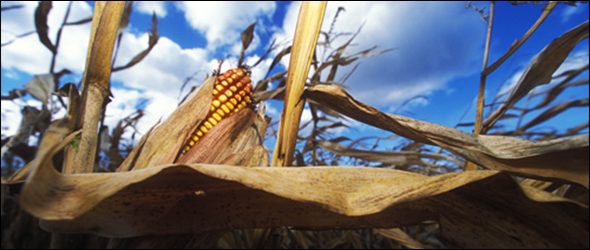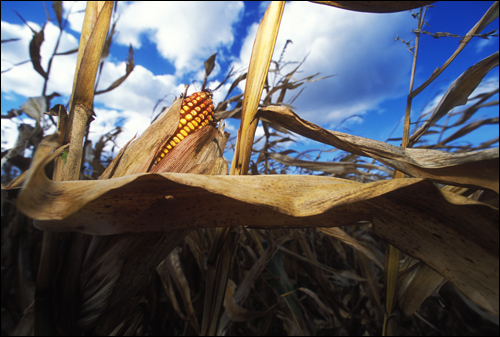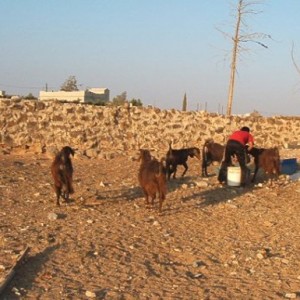Breaking Laws of Supply and Demand: Record U.S. Corn Crop Not Likely to Lower Food Prices
Favorable weather and prices, driven up by growing global demand and a series of droughts, have combined to push U.S. corn production to a new high — but retail food costs are not expected to drop.

By Codi Yeager-Kozacek
Circle of Blue
Farmers in the United States are on track to produce a projected 376 million metric tons (14.79 billion bushels) of corn for the 2012-2013 fiscal year, according to the latest Feed Outlook released by the U.S. Department of Agriculture (USDA). Supplies from this record crop are expected to dampen high corn prices that have been pushed up by strong demand and drought, but are unlikely to translate into lower bills at the grocery store.
If the projections are realized, the U.S. corn output will be nearly 62 million metric tons (2.4 billion bushels) larger than last year’s, and almost 43 million metric tons (1.69 billion bushels) larger than the previous record set in 2009-2010.
The high production projections are due to several factors, including an unusually warm spring — which led to early planting — and a sustained period of high market prices that provided an incentive for farmers to plant more land with corn, Edward Allen told Circle of Blue. Allen is a senior economist and feed grains analyst at the USDA Economic Research Service (ERS) and was one of the authors of the recent Feed Outlook.
–Edward Allen
Senior economist and feed grains analyst
USDA Economic Research Service
The projected area that farmers have allotted to corn this year, based on the results of a USDA survey published in the March Prospective Plantings report, is 38.9 million hectares (95.9 million acres), or 1.6 million hectares (4 million acres) more than last year — it will be the largest corn planting since 1937.
“The very large area planted is a function of producers responding to prices,” Allen said. “We have had a period of sustained high prices, and farmers are responding by planting a lot of corn — that is probably the most significant factor.”
Market prices for corn have remained high in recent years due to increased demand for ethanol, steady demand for meat, and strong exports driven by rising global demand. Droughts in key production areas, like the one suffered by Argentina earlier this year, have also played a role.
“Argentina’s yield has fallen below trend for two years in a row, and — as the world’s number two corn exporter — that obviously contributes to the strength in prices,” Allen said.
Typically, yield shortfalls in places like Argentina can be balanced out by countries like the U.S. or Ukraine, the largest and third-largest corn exporters, respectively. But the uncertainty created by droughts can still drive up prices. In February, after forecasters predicted that Argentina would lose one-third of its corn crop to drought, prices for corn reached $US 249.20 to $US 258.80 per metric ton ($US 6.23 to $US 6.47 per bushel).
“When Argentina started going into drought, the market took off,” Paul Bertels, vice president of production and utilization at the National Corn Growers Association, told Circle of Blue.
–Ricky Volpe
Research economist
USDA Economic Research Service
The large U.S. yield, as well as large yields from foreign producers, is expected to drive prices down to $US 165.50 to $US 197.00 per metric ton ($US 4.20 to $US 5.00 per bushel) in 2012-2013, according to the Feed Outlook. Corn prices, along with the prices of the other major commodities — wheat, soybeans, and rice — can have a significant impact on the cost of food. The USDA estimates that the value added of the farm and agribusiness sector is about 10 to 11 cents on the food dollar, meaning that for every dollar spent on food, around 10 percent goes to farmers. Fuel makes up a similar proportion of the food dollar.
“Fuel and commodities have comparable impacts on retail food prices, and they will probably balance each other out, so we cannot expect food prices to undergo deflation,” Ricky Volpe, a research economist with the USDA ERS, told Circle of Blue. “And at a global level, in general, demand is outpacing supply. So, even though we are having a banner year for lots of crops — which will deflate the commodity price — we will not see deflation at the retail level.”
And a banner year for corn, though likely, is not in the bag yet.
“We’re entering what we call ‘God’s part’ of the harvest,” Bertels said. “We’ll see if we get enough rain or too much rain, if it is warm enough or too warm. The big things to watch are drought and high night-time temperatures.”
–Paul Bertels
VP of Production and Utilization
National Corn Growers Association
Last year, U.S. corn yields were hit with both during one of the most important phases of the growth cycle — pollination.
A heat wave in July kept temperatures above 80 degrees Fahrenheit overnight and the rains stopped, while daytime temperatures above 26 degrees Celsius (95 degrees Fahrenheit) may have sterilized pollen, Bertels said. This year, however, the early planting and emergence of corn plants, which correlates statistically with higher yields, could keep them out of the worst of summer’s heat.
The Feed Outlook shows that 71 percent of the corn crop has been planted, 24 percent more than average and 39 percent more than last year.
“We had a warm and favorable spring and got a good jump on planting,” Bertels said. “If the plants are allowed to mature early, then they will hit pollination in the end of June, before the real heat starts, and they will be better off. As long as we get reasonable weather that’s not too dry and not a huge heat wave, we’ll get a record crop.”
A news correspondent for Circle of Blue based out of Hawaii. She writes The Stream, Circle of Blue’s daily digest of international water news trends. Her interests include food security, ecology and the Great Lakes.
Contact Codi Kozacek
Leave a Reply
Want to join the discussion?Feel free to contribute!










Isn’t the other reason that food prices will not be impacted is the fact tht most of the corn is genetically engineered and many food manufacturers will not use it? And, why if it is not acceptable in that facet of the industry, are these corn types and distiller’s grains (from ethanol plants) acceptable for the livestock feed industry? The impacts of WDG are not tested – even most MSDS on WDG doesn’t show the toxin values, and there does not seem to be a study on the impacts on meat products. Dairy, swine and poultry are tested, not beef. Antiquated ration perspectives, overfeeding of corn and the easy reliance on WDS is causing massive death ratios and meat quality impacts in feedlots. Maybe someone should look into that.